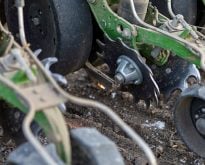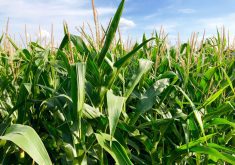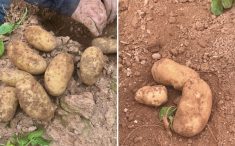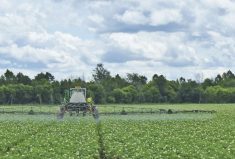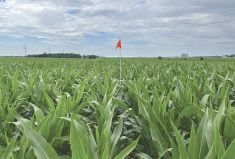In the past 12 months, there have been plenty of discussions, presentations and stories in the farm media about fertilizer use. The topics have covered its many forms, its costs and volatility, sources and reserves, even perspectives on preparing to manage your fields with less.
In the middle of the winter meeting season last year, Dale Cowan, senior agronomist and sales manager with AGRIS and Wanstead Co-operatives with locations throughout southwestern Ontario, began posting questions on Twitter concerning the use of nitrogen-based fertilizers. Cowan has been challenging farmers for years to justify their use of everything from variable-rate technology to soil health issues to fertility programs.
Read Also

Will investments in defence benefit Canadian agriculture?
A bump in Canada’s NATO spending commitments could lead to infrastructure investments that would benefit rural areas
That’s why he began posting questions about methods of application, timing, sources of nutrients, measuring the effects of N-based fertilizers and the different forms of N that can be applied (see the full list at bottom).
Cowan says the idea came from Dr. Howard Brown of Growmark, in Bloomington, Illinois. Fall-applied anhydrous ammonia is common in the U.S. Corn Belt, yet among farmers and industry stakeholders, there have been increasing concerns about elevated nitrate levels in groundwater, including mid-summer pollution events in 2014 and 2015. This has led to a better understanding of what’s actually happening with nitrogen applications and other fertilizers and inputs.
“From this came the N Watch program for tracking nitrogen behaviour all season long,” says Cowan. “That turned into the acronym M.O.M.: Minimize the size of the environmental foot print, Optimize harvested yield, Maximize nutrient utilization.”
This in turn builds on the 4R Nutrient Stewardship construct (the Right source of fertilizer, the Right rate at the Right time and in the Right place).
For agriculture, says Cowan, the choice is simple. If you aren’t going to adopt the 4R’s, you have to go for the 4D’s: Defend, Deny, Delay and Duck.
But agriculture also has some learning to do, Cowan says. Most farmers know there’s a nitrogen cycle, but terms such as amminization, ammonification, mineralization, immobilization and volatilization can still make many peoples’ eyes glaze over. (The exception is leaching, which is well understood by most farmers.)
- Read more: No fertilizer panic – for now
Cowan’s 20 Questions are in part a step-wise evaluation for farmers to assess how their decisions on rates, timing, sources and placement of different N sources affect yield and environmental outcomes, without having to draw the N-cycle schematic.
“The big concern is over large, single, pre-plant applications that are at high risk of environmental loss, which results in lower yields and overall disappointments,” Cowan says. “Splitting of N applications doesn’t necessarily mean more N, unless the yield potential is there. It may mean an extra application cost, but experience suggests it has paid for itself with more yield, especially in 2015.”
That’s not to say that a corn crop doesn’t need N up front, because obviously it does. But it’s also worth the effort to determine how much pre-plant fertilizer, starter side-dress or early side-dress applications are being made. And the 20 questions help with that process.
Getting precise about fertility
On today’s farms, when it’s time for a particular task to be performed, nothing else matters. If it’s planting season, Cowan says, the “need for speed” is paramount, and nothing can be allowed to get in the way, even as an option.
“But in my mind, if the 20 questions cause a farmer to stop and examine what they’re doing, tear it down and then re-assemble the system, that’s good,” says Cowan. “If it goes back together as it was, then at least they know the consequences of their program decisions.”
Where he sees the most value with the 20 questions is for farmers who are expanding their geography and beginning to run into different soil textures and productivity capacity soils on rented land. This is where one size does not fit all, and it may be worth the extra time to plan for different N strategies.
Measuring the impact is also part of this approach: the use of systems such as N Watch or INCrop are similar to soil testing. Yes, there are costs involved — N Watch is a sentinel system that requires about $300 worth of nitrate soil tests and delivers the results as part of a web-based system. It tracks behaviour as opposed to making N recommendations. But the more information you have, the better-informed decisions you can make. INCrop applications vary from $10 to $14 per acre and may or may not come with an additional cost, depending on a farmer’s current N application methods.
“As with most systems, it’s simply a decision to do it,” says Cowan, adding that making such a decision is similar to taking what can be a difficult first step into variable rate technology. Yet there are components of production that become more apparent with each step. “For instance, yield is constrained by soil moisture prior to the reproductive stages, so moisture drives yield potential, and yield potential drives N demand. We need to have a system where N application is flexible to make adjustments late in a season, and a system to evaluate yield potential.”
Cowan also notes there are some rapid test systems coming to the market, where testing can be done in the field. Reports are variable in terms of their relative accuracy and consistency, but there are definite savings in both time and the expense of sending a sample to the lab.
“With N Watch, if sites are strategically placed in various management systems and soil textures, we can track those with regular timed nitrate tests that include ammonium and nitrate at two depths,” says Cowan. “So there’s the ability to understand conversion rates and movement, and to be able to make adjustments to application strategies later in-season. And we’d also have an environmental report card demonstrating due diligence in managing N supply.”
There is also research being done with weather records and models and stand evaluations. But N use really comes down to application, timing and whether you use protected N sources. In high-yield environments, Cowan says farmers should plan for fluidity, both in budget rates and timing. In fact, “Nitrogen Management as a System” should be a separate line item in the annual budget.
In recent years, there have been springtime concerns about fertilize supply. It’s been a result of larger farms, tighter planting and application windows, and poor short-term memory.
Instead, Cowan sees an opportunity. He points to the potential for farmers to enter into supply chain agreements with dealers and retailers. The level of sophistication in supply and supply management is increasing, and deciding early on how N is to be applied and at what rates would make a farmer an attractive partner is such an agreement.
“The days of bottomless warehouses and endless supply available at the last minute are slowly slipping away — if they’re not gone already,” says Cowan. “We encourage our farmers to get crop plans done early with their crop specialists, run through the 20 questions, get a fertility plan done early, then spend the time at the critical moment executing a well thought-out plan.”

Also, Cowan suggests farmers have a look at the Great Lakes Agricultural Stewardship Initiative (GLASI), currently being promoted on the Ontario Soil and Crop Improvement Association (OSCIA) website. He emphasizes that it’s a good exercise for farmers to go through. In this 22-page self-assessment, farmers can see more of the impact of their farming practices, with additional evaluation of a certified crop adviser (CCA). Together, this will help establish a benchmark of aggregated data concerning general soil and pollinator health status and nutrient use as well as conservation practices in Ontario.
And, as Cowan points out, combining the information from GLASI with answers to the 20 questions on N use, it’s surprising what farmers can learn about their farms and their management practices.
To learn more, go to the Ontario Soil and Cropland Improvement website.
Nitrogen’s 20 Questions
- How do you determine your total N requirements for corn?
- How many times do you apply N?
- Do you allocate N credits from previous crops, such as forage legumes, red clover, soybeans, sweet corn or cover crops?
- Do you allow for an N credit from your starter fertilizer program?
- Do you allow for an N credit from fall-applied MAP (mono-ammonium phosphate) or manure?
- Do you apply N to corn stalks in the fall to break them down? (If so, is it effective, or a waste of N?)
- Have you modified N rates based on a nitrate soil test, plant tissue, stalk test or NDVI (normalized difference vegetation index) from drone imagery?
- How many pounds of actual N do you apply pre-plant?
- What is the rate of N in your corn starter? Does it change based on side-dress or pre-plant N rates?
- What is your typical side-dress rate of N? Do you vary by soil type or organic matter content?
- With approximately 40 per cent of N taken up after full-tassel stage, have you considered late-season in-crop application of N?
- Do you use manure as an N source? Do you have a manure test? When do you apply, and what’s the method of application?
- What sources of N products do you use: UAN (urea ammonium-nitrate), urea, ammonium sulphate, NH3 (ammonia), Smart N? Do you use more than one?
- Have you used products to prevent or limit your environmental losses?
- Have you used any of these products to protect N: SmartN, Agrotain Ultra, Agrotain Plus, Nserve or eNtrench?
- Have you taken a nitrate soil test in the fall, after harvest?
- Have you taken harvest samples to a lab and tested for N content per bushel by hybrid?
- Have you calculated your N use efficiency (i.e. N removed over total N available across the field)?
- Are you doing variable-rate N applications using your captured, multiple-year site-specific data?
- Have you heard of N Watch and INCrop Nitrogen management systems?




